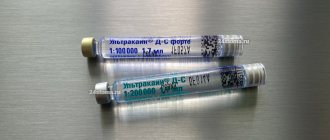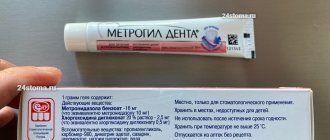From this article you will learn:
- How effective is novocaine?
- which is better - novocaine or lidocaine,
- Is it possible to dilute ceftriaxone with novocaine (or cefazolin).
The article was written by a dental surgeon with more than 19 years of experience.
Novocaine (procaine) is a local anesthetic with moderate analgesic activity that was widely used in the past for anesthesia in dentistry and general surgery. Currently, novocaine is available in the form of a 0.5 or 2% solution, in ampoules of 5 ml. In terms of the effectiveness of pain relief, it is much weaker than other anesthetics (for example, it is weaker than lidocaine - 2.5 times, and an anesthetic such as ultracaine - at least 4-5 times).
This anesthetic was previously widely used in the USSR for local anesthesia. In dentistry, it was used to remove teeth and open purulent abscesses, and in general surgery - to perform any operations under local anesthesia. Novocaine is currently not used in dentistry (it has been replaced by anesthetics based on articaine). In general surgery, novocaine is currently replaced by lidocaine - due to the greater safety and effectiveness of the latter.
Anesthetic Novocaine (in modern plastic ampoules) –
Release form and components included in the composition
The drug belongs to the group of local anesthetics, including those used for painless treatment and tooth extraction, as well as other dental procedures. "Novocaine" is presented in different dosage forms:
- solution for injection 0.5% – colorless liquid, packaged in ampoules of 2, 5 and 10 ml. One package contains 10 ampoules, a scarifier or a special ampoule knife,
- solution 0.25% - sold in ampoules of 1, 2, 5 and 10 ml, 10 ampoules per package,
- solution 1% – packaged in ampoules of 1, 2 and 5 ml, 10 pieces per package,
- solution 2% - can be slightly colored, sold in 2 and 5 ml ampoule, 10 pieces each complete with a scarifier or ampoule knife.
The solution is packaged in ampoules.
The drug is based on the main active ingredient - procaine hydrochloride. 1 ml may contain 2.5; 5; 10 and 20 mg, depending on the concentration of the solution. The anesthetic is also presented in the form of suppositories - 100 mg each.
Technology of infiltration anesthesia behavior
- First, the area where the drug is administered is treated with an antiseptic.
- The doctor takes a comfortable position near the patient (on his right side).
- The doctor exposes the working area of the mouth by pulling back the cheek or lip. This action can be performed by hand or with a special tool.
- The specialist places the tip of the needle on the transitional fold, maintaining an inclination angle of 45° (relative to the alveolar ridge). The cut of the needle should be directed towards the jawbone.
- Next, the doctor carefully inserts the needle until it touches the bone tissue. The immersion depth can be 5-15 mm, depending on the jaw area.
- The anesthetic is smoothly injected from a syringe into the tissues of the oral cavity.
Pharmacology and pharmacokinetics
The solution has a moderate anesthetic effect. Its active components reduce the excitability of the motor areas of the brain and myocardium, relieve spasms of smooth muscles. The drug also helps reduce blood pressure and arrhythmia, and helps relieve shock. However, exceeding the permissible dosages of Novocaine is fraught with impaired muscle conduction and cramps - we’ll talk about other possible complications a little later. In the meantime, it should be noted that the drug is poorly absorbed through the mucous membranes. Its active ingredients are excreted primarily by the kidneys - 80%.
Instructions for use in dentistry and recommended dosages
As part of infiltration anesthesia, 350-600 mg of a 0.25-0.5% solution is used. For pain relief using the Vishnevsky method, a solution is used in a concentration of 0.125-0.25%. For conduction, 25 ml of a 1-2% solution is enough, and for an epidural - 20-25 ml of a 2% solution1.
The drug is used for epidural anesthesia
In order to prolong the anesthetic effect, the doctor may additionally administer epinephrine 0.1%. The maximum permissible dose when performing infiltration anesthesia for an adult patient is 1 g of 0.25% solution, that is, no more than 500 ml, as well as 0.75 g of Novocaine 0.5%, or no more than 150 ml. The maximum dose for children should not exceed 15 mg per 1 kilogram of the child’s weight.
Novocaine solution d/in 0.5% 5 ml x10
Trade name: Novocaine
International name: Procaine&, (Procaine)
Pharmacological group: antiarrhythmic agent, local anesthetic
Pharmacological action: local anesthetic
Pharmacodynamics:
A local anesthetic with moderate anesthetic activity and a wide range of therapeutic effects. Being a weak base, it blocks Na+ channels, preventing the generation of impulses in the endings of sensory nerves and the conduction of impulses along nerve fibers. Changes the action potential in the membranes of nerve cells without a pronounced effect on the resting potential. Suppresses the conduction of not only pain, but also impulses of other modalities.
When absorbed and directly vascularly introduced into the bloodstream, it reduces the excitability of peripheral cholinergic systems, reduces the formation and release of acetylcholine from preganglionic endings (has some ganglion-blocking effect), eliminates spasm of smooth muscles, reduces the excitability of the myocardium and motor zones of the cerebral cortex.
When administered intravenously, it has an analgesic, antishock, hypotensive and antiarrhythmic effect (increases the effective refractory period, reduces excitability, automaticity and conductivity); in large doses it can disrupt neuromuscular conduction.
Eliminates descending inhibitory influences of the reticular formation of the brain stem. Inhibits polysynaptic reflexes. In large doses, it can cause convulsions. It has a short anesthetic activity (the duration of infiltration anesthesia is 0.5-1 hour).
When administered intramuscularly, it is effective in elderly patients in the early stages of diseases associated with functional disorders of the central nervous system (arterial hypertension, spasms of coronary and cerebral vessels, etc.).
Pharmacokinetics:
Subject to complete systemic absorption. The extent of absorption depends on the site and route of administration (especially vascularity and blood flow velocity in the area of administration) and the final dose (amount and concentration). It is quickly hydrolyzed by plasma and liver esterases to form 2 main pharmacologically active metabolites: diethylaminoethanol (has a moderate vasodilator effect) and PABA (is a competitive antagonist of sulfonamide chemotherapeutic drugs and can weaken their antimicrobial effect).
T1/2 - 30-50 s, in the neonatal period - 54-114 s. It is excreted primarily by the kidneys in the form of metabolites; no more than 2% is excreted unchanged.
Indications for use:
Infiltration (including intraosseous), conduction, epidural, spinal anesthesia, vagosympathetic cervical and perinephric blockade, retrobulbar (regional) anesthesia, terminal (superficial) anesthesia (in otorhinolaryngology)
Rectal: hemorrhoids, anal fissures.
Contraindications:
Hypersensitivity (including to PABA and other local anesthetic ethers).
For anesthesia using the creeping infiltration method: pronounced fibrous changes in tissues; for subarachnoid anesthesia - AV block, bleeding, arterial hypotension, shock, infection of the lumbar puncture site, septicemia.
Carefully:
Emergency operations accompanied by acute blood loss, conditions accompanied by decreased hepatic blood flow (for example, with CHF, liver diseases), progression of cardiovascular failure (usually due to the development of heart block and shock), inflammatory diseases or infection of the injection site, pseudocholinesterase deficiency, renal failure, children's age (up to 18 years), in elderly patients (over 65 years), seriously ill, debilitated patients,
pregnancy, childbirth.
For subarachnoid anesthesia: back pain, brain infections, benign and malignant brain tumors, coagulopathy, migraine, subarachnoid hemorrhage, arterial hypotension, skin paresthesia, psychosis, hysteria, non-contact patients, impossibility of puncture due to spinal deformity.
Dosage regimen:
For infiltration anesthesia 350-600 mg 0.25-0.5% solutions, for anesthesia according to the Vishnevsky method (tight creeping infiltration) - 0.125-0.25% solutions, for conduction anesthesia - 1-2% solutions (up to 25 ml), for epidural - 2% solution (20-25 ml), for spinal - 5% solution (2-3 ml), for terminal anesthesia (in otorhinolaryngology) - 10-20% solution.
To reduce absorption and prolong the effect of local anesthesia, an additional 0.1% solution of epinephrine hydrochloride is administered - 1 drop per 2-5-10 ml of procaine solution.
For perinephric blockade (according to A.V. Vishnevsky), 50-80 ml of a 0.5% solution or 100-150 ml of a 0.25% solution are injected into the perirenal tissue, and for vagosympathetic blockade - 30-100 ml of a 0.25% solution.
A 10% solution is also used for electrophoretic administration.
Higher doses for infiltration anesthesia for adults: the first single dose at the beginning of the operation is not higher than 1 g of 0.25% solution (500 ml) and 0.75 g of 0.5% solution (150 ml).
The maximum dose for use in children is up to 15 mg/kg.
Rectally.
Having previously freed the suppository from the contour packaging using scissors (cutting the packaging along the contour of the suppository), insert it deep into the anus (after a cleansing enema or spontaneous release of the intestines) 1-2 times a day.
Side effects:
From the central and peripheral nervous system: headache, dizziness, drowsiness, weakness, motor restlessness, loss of consciousness, convulsions, trismus, tremor, visual and auditory disturbances, nystagmus, cauda equina syndrome (leg paralysis, paresthesia), respiratory muscle paralysis, motor and sensory block, respiratory paralysis more often develops with subarachnoid anesthesia.
From the cardiovascular system: increase or decrease in blood pressure, peripheral vasodilation, collapse, bradycardia, arrhythmias, chest pain.
From the urinary system: involuntary urination.
From the digestive system: nausea, vomiting, involuntary bowel movements.
Blood disorders: methemoglobinemia.
Allergic reactions: skin itching, skin rash, other anaphylactic reactions (including anaphylactic shock), urticaria (on the skin and mucous membranes).
Other: return of pain, persistent anesthesia, hypothermia, impotence, during anesthesia in dentistry: numbness and paresthesia of the lips and tongue, prolongation of anesthesia.
Overdose:
Symptoms: pallor of the skin and mucous membranes, dizziness, nausea, vomiting, cold sweat, increased breathing, tachycardia, decreased blood pressure, even collapse, apnea, methemoglobinemia. The effect on the central nervous system is manifested by a feeling of fear, hallucinations, convulsions, and motor agitation.
Treatment: maintaining adequate pulmonary ventilation with oxygen inhalation, intravenous administration of short-acting drugs for general anesthesia, in severe cases - detoxification and symptomatic therapy.
Interaction:
Local anesthetics enhance the inhibitory effect on the central nervous system of other drugs.
Anticoagulants (ardeparin sodium, dalteparin sodium, danaparoid sodium, enoxaparin sodium, heparin, warfarin) increase the risk of bleeding.
When treating the injection site of a local anesthetic with disinfectant solutions containing heavy metals, the risk of developing a local reaction in the form of pain and swelling increases.
When using local anesthetic drugs for spinal and epidural anesthesia with guanadrel, guanethidine, mecamylamine, trimethaphan, the risk of developing a sharp decrease in blood pressure and bradycardia increases.
Use with MAO inhibitors (furazolidone, procarbazine, selegiline) increases the risk of developing a pronounced decrease in blood pressure.
Strengthen and lengthen the effect of muscle relaxant drugs.
When procaine is prescribed together with narcotic analgesics, an additive effect is noted, which is used during spinal and epidural anesthesia, while respiratory depression increases.
Vasoconstrictors (epinephrine, methoxamine, phenylephrine) prolong the local anesthetic effect.
Procaine reduces the antimyasthenic effect of drugs, especially when used in high doses, which requires additional correction in the treatment of myasthenia gravis.
Cholinesterase inhibitors (antimyasthenic drugs, cyclophosphamide, demecaria bromide, ecothiopathy iodide, thiotepa) reduce the metabolism of local anesthetic drugs.
Procaine metabolite (PABA) is an antagonist of drug sulfonamides.
Special instructions:
Patients require monitoring of the functions of the cardiovascular system, respiratory system and central nervous system.
It is necessary to discontinue MAO inhibitors 10 days before the administration of a local anesthetic.
During the treatment period, care must be taken when driving vehicles and engaging in other potentially hazardous activities that require increased concentration and speed of psychomotor reactions.
Contraindications for use
The drug has an impressive list of contraindications and restrictions for use. Thus, “Novocaine” and all its procaine-based forms are not used if the patient has hypersensitivity and allergies to the components included in the composition. As for whether Novocain can be given to a child, it is important to pay attention here: this anesthetic is prohibited for children under 12 years of age.
The drug should not be used by children under 12 years of age
Increased caution is required in cases of emergency surgical interventions with high rates of blood loss, as well as conditions of chronic, acute and progressive heart failure, liver and kidney diseases, pseudocholinesterase deficiency, age from 12 to 18 years, elderly age from 65 years, severe pathological conditions, pregnancy , childbirth, breastfeeding.
What are the possible side effects?
There is an opinion that Novocain can cause epilepsy, but this is not entirely true. This anesthetic belongs to the category of drugs that, under certain conditions, can provoke epileptic seizures in patients with epilepsy or hypersensitivity to the active substances.
According to the instructions for use, this painkiller can also lead to disorders of the cardiovascular system, including sudden surges in pressure, bradycardia, arrhythmia, chest pain, and collapse. Among other adverse reactions, experts identify headache and dizziness, weakness, trismus, as well as malfunctions of the hematopoietic organs. Allergic manifestations include skin itching, rashes, urticaria and anaphylactic reactions.
Side effects may include headache and dizziness
How Novocain interacts with other medications
Other anesthetic drugs increase CNS depression. Anticoagulants contribute to blood clotting disorders, and the simultaneous use of disinfectant solutions with heavy metals significantly increases the likelihood of developing swelling and pain.
MAO inhibitors reduce blood pressure. When using Novocaine simultaneously with narcotic analgesics, an additive effect is observed. Vasoconstrictors, such as epinephrine (synthesized adrenaline), help prolong the anesthetic effect.
Interactions with other drugs should be considered before use.
What is the difference between Novocaine and Ultracaine?
Novocaine is one of the oldest painkillers used in dental practice. It was first synthesized by the German chemist Alfred Einhorn back in 1898. At that time, it became the best replacement for cocaine, which had previously been used for pain relief.
But now Novocain is used extremely rarely for local anesthesia. It has a very long latency period, that is, the effect after its administration occurs only after 10,15 or even 20 minutes. Modern drugs, like Ultracaine, begin to act after 2-3 minutes, and this is a significant difference. In addition, “Ultracain” is almost 5 times stronger than “Novocain”, it is quickly destroyed and eliminated from the body, does not inhibit the functioning of internal organs and systems, does not cause such serious adverse reactions, therefore there are significantly fewer contraindications to it.
"Ultracain" is almost 5 times stronger than "Novocain"
“I had my canals treated with septanest, in my opinion it was not with procaine, but with articaine. This is a more modern drug, it is more effective and less harmful to the body. In general, I heard about Novocaine that it is already a thing of the past. It is no longer used in normal private dentistry. Therefore, if you want to treat your teeth without pain, you will have to choose a normal clinic that has good modern drugs.”
Marina_1987, from correspondence on the forum www.32top.ru
"Ultracaine" is used only for injection pain relief. It is often administered together with vasoconstrictors to prolong the effect, but they can cause arrhythmia and increase blood pressure. Therefore, the doctor combines medications individually for each clinical case.
Operating principle of infiltration anesthesia
Infiltration anesthesia is one of the methods of pain relief.
It involves the introduction of an anesthetic into the skin or mucous membrane, as a result of which nerve impulses are blocked. This type of pain relief is known as “freezing.” The drug used by the doctor suppresses the nerve impulse that goes from the pulp to the brain. Therefore, the patient loses sensation in some parts of the face or mouth, such as the cheek, lip or tongue. Numbness occurs in the part of the face where the anesthetic is injected. The anesthetic is administered by injection. First, the drug enters a certain area under the skin, and then is distributed among the cells. The maximum duration of the anesthetic dose is one hour. Gradually the medication breaks down and sensitivity returns. If necessary, another dose of the drug may be administered. The anesthesia process is under the supervision of a specialist.
Distinctive features of infiltration anesthesia
Infiltration anesthesia differs from other methods of pain relief by its immediate action and the exact duration of the analgesic effect. The components of the drug are very quickly eliminated from the body and do not have a negative effect on it. Infiltration anesthesia is also characterized by a low concentration of medications used.
Indications for the use of infiltration anesthesia in dentistry
- Treatment of dental diseases (caries, pulpitis, periodontal inflammation).
- Surgical treatment of periodontal diseases (curettage, gum plastic surgery, elimination of defects and tissue regeneration).
- Dental prosthetics without pulp removal (installation of crowns, inlays, bridge structures).
- Treatment with surgical intervention (tooth extraction, implantation, tissue expansion, emptying of purulent cavities, opening of phlegmons, excision of cysts).
Contraindications
- An allergic reaction to a pain reliever.
- Mental disorders of the patient that prevent constructive communication with him.
- Excessive psychomotor agitation.
- Children under 10 years of age (relative contraindication).
- Asthma and other pathologies of the respiratory system.
- Using muscle relaxants to relax muscles.
- The presence of scars on the mucous membranes of the oral cavity, which prevent the uniform distribution of the drug.
- Inflammatory or purulent process in the area of anesthetic administration.
- The presence of malignant neoplasms or tumors suspected of cancer.
- Refusal of the patient to use this method of anesthesia.
Storage conditions, expiration date and prices in Moscow pharmacies
“Novocaine” in the form of a 0.5% injection solution will cost from 40 to 60 rubles per 200 ml bottle. To buy the drug at a pharmacy, you will have to present a prescription from a doctor. Ampoules should be stored in a dry, dark place out of reach of children and pets. According to the instructions, the shelf life is 3 years.
Before administering an anesthetic, the patient must warn the doctor about possible allergic reactions or chronic pathologies in his medical history. The specialist selects anesthesia, taking into account all the available nuances. Novocaine was one of the first painkillers to become widely popular in dental practice. However, today dentists have better, more effective and safe means in their arsenal for painlessly carrying out procedures of any complexity.
1Rabinovich S.A., Anisimova E.N., Zoryan E.V. Main directions of drug therapy for pain syndrome in dentistry, 2001.
Advantages of infiltration anesthesia
- This type of anesthesia is safe, as it allows the use of solutions in low concentrations.
- The effect of infiltration anesthesia is much faster than conduction anesthesia.
- The area where the anesthetic is administered loses sensation for a long period of time.
- It is possible to administer an additional dose of the drug if long-term treatment is necessary.
- The anesthetic drug is very easily eliminated from the body in a short time.
- Loss of sensation occurs not only in the nerve into which the anesthetic was injected, but also in neighboring nerves.







